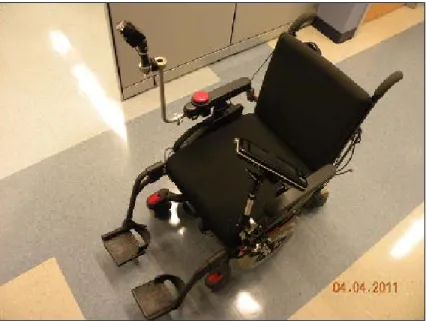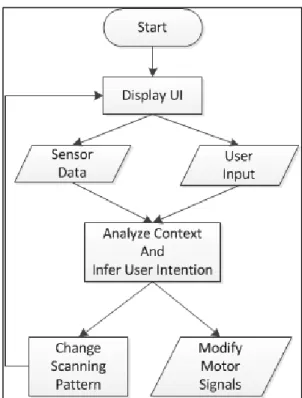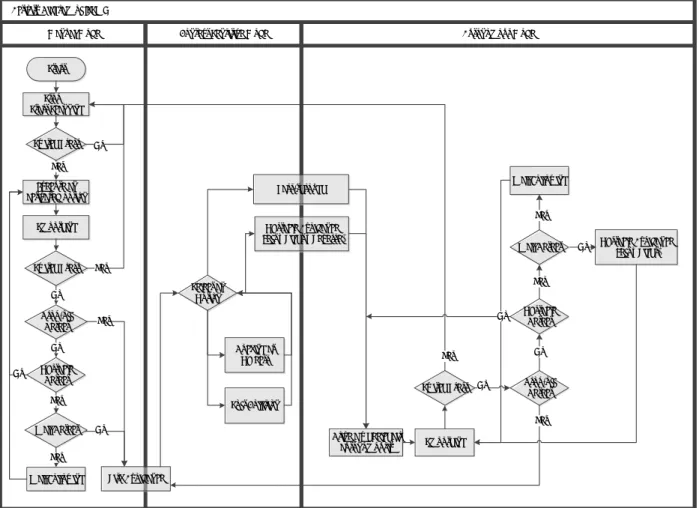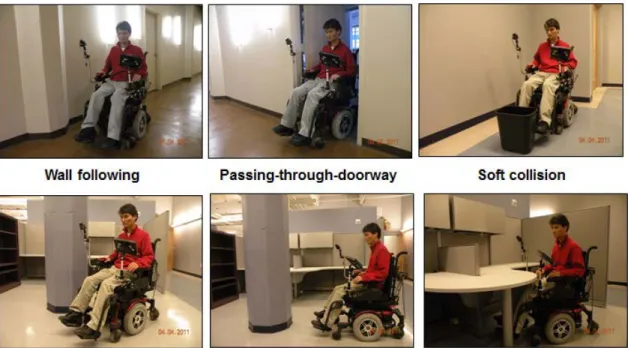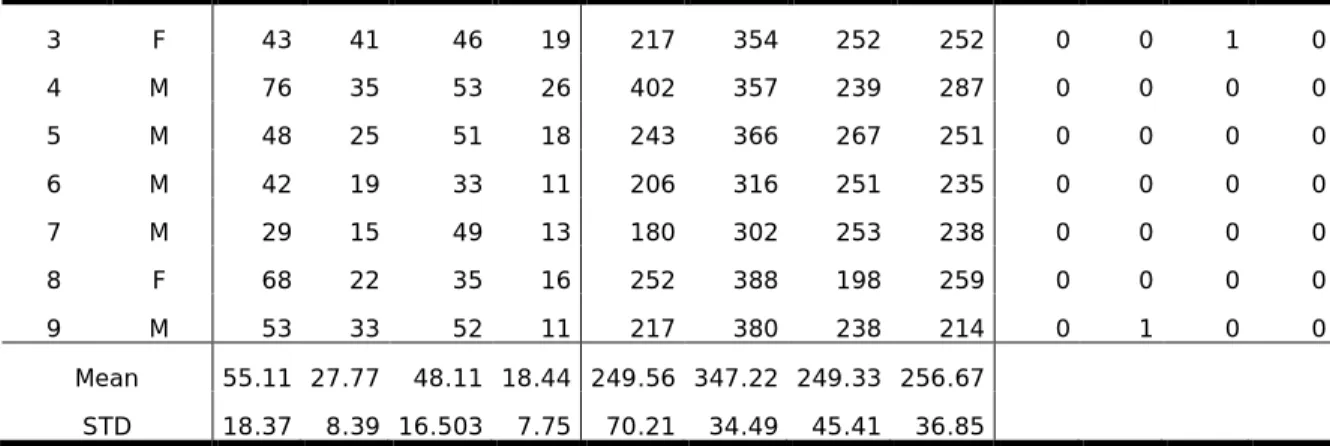Intelligent Single Switch
Wheelchair Navigation
Abstract
We have developed an intelligent single switch scanning interface and wheelchair navigation assistance system, called ISSWN, to improve driving safety, comfort, and efficiency for individuals who rely on single switch scanning as a control method. ISSWN combines a standard powered wheelchair with a laser rangefinder, a single switch scanning interface and a computer. It provides the user with context sensitive and task specific scanning options that reduce driving effort, based on an interpretation of sensor data together with user input. Trials performed by 9 able-bodied participants showed that the system significantly improved driving safety and efficiency in a navigation task.
Introduction
Mobility limitations are not only strong predictors of difficulties with activities of daily living, but also act as a primary factor to decrease educational, social, and vocational opportunities, which can result in social isolation, anxiety, and depression [1]. Conventional manual and powered wheelchairs or scooters are good alternatives for many people with physical disabilities. However, some people who have severely impaired motor functions or have a combination of multiple disabilities have found it difficult or impossible to use traditional mobility devices independently [2, 3]. In order to accommodate this population, several research groups have designed smart wheelchairs, which combine a power wheelchair with a set of sensors and a computer [4]. However, while most efforts to develop smart wheelchair technology have focused on improving navigation such as assuring collision-free travel, aiding the performance of specific tasks, and autonomously transporting the user between locations [4], research focusing on input methods for smart wheelchairs has been less frequent. In addition to a joystick, several kinds of
input method have been used to operate smart wheelchairs, including voice recognition [5], sight path tracking [6], machine vision [7, 8], and single switch scanning.
Single switch scanning is one of the least efficient methods for people with severe motor impairments to operate power wheelchairs. Problems with single switch wheelchair navigation include: frequent stops to counteract drift and to avoid obstacles, increased driving time, and frustration and fatigue in challenging environments such as narrow hallways. Several approaches to improve performance with single switch scanning interface have been investigated, [9-14] but most of this research focused on automating scan rate adjustment for entering text into computers and augmentative and alternative communication devices, not on wheelchair operation. We have developed an intelligent single switch scanning interface and wheelchair navigation assistance system, called ISSWN, to improve driving safety, comfort, and efficiency for individuals who rely on single switch scanning as a control
method. As shown in Figure 1, ISSWN combines a standard powered wheelchair with a laser rangefinder, a single switch scanning interface and a computer. The laser rangefinder is used to identify features in the environment, including walls, doors and obstacles. A single switch is used as the user input device and a small laptop computer as an interface and processor.
An algorithm was developed to assist with single switch wheelchair navigation by sharing control between the wheelchair driver and the system. As shown in Figure 2, the system infers the current context based on user input representing the user’s intention and sensor data rendering environmental features to provide the user with a context sensitive scanning interface. Yanco
& Gips compared navigation performance using a single switch scanning interface between a smart wheelchair, which provided a user with wall following and obstacle avoidance, and a traditional powered wheelchair [15]. In the study, it was demonstrated that a smart wheelchair significantly surpassed a general powered wheelchair in drive performance using single switch scanning. However, while the single switch scanning interface they used provided a static scanning interface, ISSWN provides the user with context sensitive options by dynamically adjusting its single switch
scanning interface and its behavior based on the user's input and the wheelchair's surroundings.
As shown in Figure 3 and Figure 4, the user interface provided by ISSWN has three different modes: manual mode, context sensitive mode, and autonomous mode.
Figure 3. User Interfaces provided by ISSWN
Figure 4. Activity Diagram of ISSWN
In manual mode, the ISSWN makes the wheelchair stop when it detects objects or a drop-off within a set range and then switches to context sensitive mode. In context sensitive mode, ISSWN provides the user with task specific options as navigation assistance (Figure 3), including:
• Obstacle avoidance – ISSWN makes the wheelchair turn left or right until it gets enough space to go forward or backward, depending on the user's input. Then it switches to autonomous mode.
• Passing-through-doorway – ISSWN adjusts the minimum obstacle clearance used for obstacle avoidance when it detects two closely-spaced obstacles after activating the corresponding option in context sensitive mode. Then it switches to autonomous mode.
Activity Diagram of ISSWN
Context Sensitive Mode
Manual Mode Autonomous Mode
Start Stop & Start Scanning Switch Press No Execute an activated option Yes Switch Press Drop-off Detect Obstacle Detect Wall Detect Smoothing Yes No No Yes
Wall Following Risk Avoidance No Yes Yes No Select an Option Obstacle Avoidance (Left | Right | Reverse)
Pass-through Docking at Objects Soft Collision Drive a wheelchair autonomously Smoothing Switch Press Yes Drop-off Detect No Yes Obstacle Detect No Wall Detect Yes Wall Following Yes Obstacle Avoidance (Left | Right) No No
• Docking at objects – ISSWN adjusts the orientation of the wheelchair toward the object of interest, such as a table or a sink, and then gradually moves closer to the object until the user interrupts the function.
• Soft collision – ISSWN allows the wheelchair to softly "collide" with an object in order to push it out of the way.
In autonomous mode, ISSWN drives the wheelchair autonomously using orientation, proximity and relation to objects in the environment as environmental cues to restrict or direct it driving paths until the user interrupts it. ISSWN allows the user to overrule the controller at any time when he or she disagrees with the decision of the controller or when he or she feels confident enough about his or her operation at that moment.
In addition, ISSWN provides the following internal functions for improving the driving safety and comfort:
• Wall following – ISSWN tries to move parallel to the wall remaining a given distance from it.
• Drop-off detection - ISSWN stops the wheelchair when it detects a drop-off (e.g., stairs or a curb),
• Smoothing – ISSWN sends signals gradually to the motor controller to
minimize jerkiness of the motion when it needs to change its direction or behavior.
Figure 5. Examples of Navigation Assistance
An experiment was performed to determine if the ISSWN increases driving safety and efficiency. The following hypotheses were tested:
1. The ISSWN would make a significant difference in the number of switch presses required to complete a navigation task compared to traditional single switch wheelchair navigation.
2. The ISSWN would make a significant difference in the time taken to complete a navigation task compared to traditional single switch wheelchair navigation.
Methods
Participants
Ten able-bodied participants (M=5, F=5), ranging in age from 22 to 62, were recruited. The inclusion criteria were:
• Participant understood the purpose and nature of the experimental task; • Participant was over 21 years of age;
• Participant was healthy enough to perform the wheelchair navigation task; • Participant had sufficient visual acuity to perform the navigation task. Each participant’s eligibility was determined based on an interview conducted before a written informed consent form was documented. All participants were recruited, and written consents were obtained, in accordance with the Institutional Review Board for the Protection of Human Subjects at the University of Pittsburgh.
Instruments
Two different wheelchair navigation conditions were compared; the powered wheelchair controlled with a manual single switch scanning interface was referred to as System A, and the powered wheelchair operated with navigational support provided by ISSWN was referred to as System B. The computer attached to the powered wheelchair automatically alternated between System A and System B for each trial. While participants were performing the navigation tasks, the computer recorded performance data, including how many times the participant pressed a switch, how long did the subject take to complete the trial and how many times the participant collided with obstacles.
Two different obstacle courses were designed for the experiment, each of which was a 10 by 5 meter enclosed rectangular area (Figure 6). In each course, eight obstacles made from unsecured cardboard boxes were placed in predefined locations and two closely-spaced obstacles were positioned at the final destination to test a doorway-passage. In order to complete the navigation task, each participant had to start at the designated position, move around the obstacle courses, turn around the yellow flag, return to the start of the course and pass through the doorway. During the task, he or she had to avoid obstacles and change directions several times.
Figure 6. Opened-up View of Obstacle Courses
Experimental Procedures
Each participant completed two sessions performed on the same day. During the first session, investigators collected demographic information about each participant. Then, participants were given an opportunity to practice using the device to become familiar with its operation with both System A and System B. A Two-second scan delay was used by all participants for System A and System B. In the second session, each participant was asked to complete a navigation task for a total of 4 times (once for each combination of course and experimental condition). For each trial the computer alternated between System A and System B. The order of experimental condition and course was randomized.
Results
The results from each subject are reported in Table 1. A one-way repeated measure multivariate analysis of variance was used to compare the number of switch presses and the time taken to complete the navigation task. Since collisions were extremely rare, they were excluded from statistical analysis. Data from the first participant was excluded from the data analysis because the ISSWN system was modified after this subject had participated in the study.
Case # Gender
Number of Switch Press Completion Time (sec) Number of Collisions
1st two trials 2nd two trials 1st two trials 2nd two trials 1st two trials 2nd two trials
A B A B A B A B A B A B
1 F 87 33 85 35 323 368 351 339 0 0 0 0
3 F 43 41 46 19 217 354 252 252 0 0 1 0 4 M 76 35 53 26 402 357 239 287 0 0 0 0 5 M 48 25 51 18 243 366 267 251 0 0 0 0 6 M 42 19 33 11 206 316 251 235 0 0 0 0 7 M 29 15 49 13 180 302 253 238 0 0 0 0 8 F 68 22 35 16 252 388 198 259 0 0 0 0 9 M 53 33 52 11 217 380 238 214 0 1 0 0 Mean 55.11 27.77 48.11 18.44 249.56 347.22 249.33 256.67 STD 18.37 8.39 16.503 7.75 70.21 34.49 45.41 36.85
Table 1. Case Summaries of the Test
The assumption of Sphericity for the number of switch presses was met (Mauchly’s W = .401, χ2(5) = 6.139, p = .297). The assumption of Sphericity for
completion time was also met (Mauchly’s W = .318, χ2(5) = 7.697, p = .178). The
assumption of normality was satisfied except for the completion time of System A in the first trial (p = .038; Table 2). Five outliers were detected: one at the number of switch presses of System A in course II, one at the number of switch presses of System B in course II, two at the completion time of System A in course I, one at the completion time of System A in course II, and one at the completion time of System B in course II. All other assumptions were met.
Measurement Trial Mode Statistic df Sig.
Number of Press 1 System A .948 9 .667 2 System B .974 9 .930 3 System A .860 9 .097 4 System B .864 9 .106 Completion Time 1 System A .824 9 .038 2 System B .891 9 .204 3 System A .850 9 .075 4 System B .858 9 .090
Table 2. Test of Normality
Significant main effects were detected in both the number of switch presses (p < .001) and completion time (p < .001). In order to find the pattern of difference for each of them, multiple custom contrast and post hoc pairwise comparisons
using the Bonferroni adjustment were performed. As shown in Table 3, the number of switch presses with ISSWN was significantly less than under normal single switch wheelchair navigation (p < .001). No learning effect on the number of switch presses was detected.
Number of Press df Mean Square F Sig. Contrast 1 29241.000 60.415 .000
Error 8
484.000
Table 3. Multiple Contrast of the Number of Switch Press between System A and B
The average completion time under the ISSWN condition was significantly longer than in normal single switch wheelchair navigation (p = .001). However, as shown in Table 4, it was found that there was a significant learning effect on completion time. While the completion time of System B in the first assigned course (M = 347, SE = 11.50) was significantly longer (p= .01) than System A in the same course (M = 250, SE = 23.40), there was not a significant difference in completion time between the completion time of System A in the second assigned course (M = 249, SE = 15.14) and System B in the same course (M = 257, SE = 12.29). There was not a significant difference in completion time between System A in the first assigned course and System A in the second assigned course. There was also not a significant difference in completion time between System A in the first assigned course and System B in the second assigned course.
Measure (I) Trial (J) Trial Mean Difference Std. Error Sig Completion Time 1 2 -97.667* 21.046 .010 3 .222 23.566 1.000 4 -7.111 16.423 1.000 2 1 97.667* 21.046 .010 3 97.889* 17.025 .003 4 90.556* 13.896 .001 3 1 -.222 23.566 1.000 2 -97.889* 17.025 .003
4 -7.333 10.928 1.000 4 1 7.111 16.423 1.000 2 -90.556* 13.896 .001
3 7.333 10.928 1.000
Table 4. Pairwise Comparisons of Completion Time
An independent sample t-test was used to validate whether the two obstacle courses designed for the experiment were equivalent. As shown in Table 5, there were no significant differences in either the number of switch presses or completion time in both System A and B between Course I and Course II.
Measurement
Mode Course Mean Std. Deviation Std. Error Mean Sig.Number of Press
System A I 46.4444 17.65015 5.88338 .215 II 56.7778 16.30780 5.43593
System B I 22.5556 9.64509 3.21503 .806 II 23.6667 9.26013 3.08671
Completion Time (sec)
System A I 226.5556 42.35301 14.11767 .091 II 272.3333 63.39164 21.13055
System B I 300.1111 56.59824 18.86608 .780 II 292.6667 54.35991 18.11997
Table 5. Course Reliability
Treating the data from the first trial of System A of each participant as 100%, we normalized the data from the other three trials and the results are displayed in a profile plot (Figure 7 & Figure 8). After normalizing the data, it was apparent that the partial violation of statistical assumptions associated with normality and outliers came from individual differences, rather than extreme cases. As shown in Figure 7, ISSWN demonstrates significant improvement in drive efficiency by reducing the number of switch presses to 43.47% of traditional single switch wheelchair navigation. As for completion time, the ISSWN took 25.9% longer on average than the traditional single switch wheelchair navigation (Figure 8). However, there was significant improvement (39.1%) in completion time between the first trial of ISSWN and the second one, and the second trial under ISSWN was not significantly different than the second trial under traditional single switch wheelchair navigation
(with an observed power of .70). This suggests that completion time with ISSWN may improve with practice.
Figure 7. Profile Plot of Number of Switch Presses Figure 8. Profile Plot of Completion Time
Discussion
Single switch scanning is a very slow method for controlling a powered wheelchair. The slow communication rate can cause frustration and fatigue as well as increased driving time. Factors that affect communication rate with a single switch scanning interface include the layout of selections within the interface, the timing parameters, and the use of additional communication rate enhancement techniques.
In order to reduce the number of scan steps required to reach the desired option, rearranging the layout of items within the scanning matrix may be considered. However, the time saved by dynamically rearranging the matrix may be offset by the cognitive overhead required to locate the desired option within the constantly shifting matrix of options [16]. ISSWN significantly reduced the number of scan steps by automatically switching between different modes of operation, each of which has a fixed layout of selections.
Another approach to increasing communication rate is to automatically adjust the timing parameters like scan delay during operation. If the scan delay is too long then the user will spend too much time waiting and communication rate will be less than optimal. On the other hand, if the scan delay is too short then the user’s timing errors will increase, which will also decrease communication rate. In either case, driving comfort and satisfaction will be compromised. Since the current work
0 20 40 60 80 100 120
System A Sytem B System A System B
N umb er o f S w itc h Pr esse s ( % ) Trial 0 50 100 150 200
System A Sytem B System A System B
Co mp le tio n T ime (%) Trial
was focused specifically on examining the efficiency of the provided interface and navigation assistance, automating the adjustment of scan delay settings was not considered here.
In terms of driving time, it was shown that ISSWN required training, like many new assistive technologies. However, as all participants made significant improvement in driving performance after only two trials, the learning curve does not appear to be very steep. This suggests that completion time with ISSWN will further improve with practice.
This study relied exclusively on able-bodied participants. It is definitely necessary to validate these results with disabled participants in a follow-up study. We are planning to collect empirical data from clinical trials with disabled individuals.
Conclusion
This research study was intended to improve the driving safety, comfort, and efficiency for individuals who rely on single switch scanning as a control method by developing an intelligent single switch scanning interface and wheelchair navigation assistance system that combines a laser rangefinder and a computer. Trials performed by 9 able-bodied participants showed that the system significantly improved the driving safety and efficiency in a navigation task.
Acknowledgement
This work is supported by National Science Foundation Quality of Life Technology Engineering Research Center (NSF QoLT ERC) #0540865.
References
[1] L. I. Iezzoni, E. P. McCarthy, R. B. Davis, and H. Siebens, "Mobility difficulties are not only a problem of old age," Journal of general internal medicine, vol. 16, pp. 235-243, 2001.
[2] A. B. Wilson, Wheelchairs: a prescription guide: Demos Medical Publishing, 1992.
[3] R. A. Cooper, Rehabilitation engineering applied to mobility and manipulation: Taylor & Francis, 1995.
[4] R. C. Simpson, "Smart wheelchairs: A literature review," Journal of rehabilitation research and development, vol. 42, p. 423, 2005.
[5] D. Cagigas and J. Abascal, "Hierarchical path search with partial materialization of costs for a smart wheelchair," Journal of Intelligent and Robotic Systems, vol. 39, pp. 409-431, 2004.
[6] H. Yanco, "Wheelesley: A robotic wheelchair system: Indoor navigation and user interface," Assistive Technology and Artificial Intelligence, pp. 256-268, 1998.
[7] Y. Kuno, N. Shimada, and Y. Shirai, "Look where you're going [robotic wheelchair]," Robotics & Automation Magazine, IEEE, vol. 10, pp. 26-34, 2003.
[8] Y. Matsumotot, T. Ino, and T. Ogsawara, "Development of intelligent wheelchair system with face and gaze based interface," 2001, pp. 262-267.
[9] S. Cronk and R. Schubert, "Development of a real time expert system for automatic adaptation of scanning rates," 1987, pp. 109–111.
[10] G. Lesher, D. Higginbotham, and B. Moulton, "Techniques for automatically updating scanning delays," 2000, pp. 85-87.
[11] G. Lesher, B. Moulton, J. Higginbotham, and A. Brenna, "Acquisition of scanning skills: The use of an adaptive scanning delay algorithm across four scanning displays," 2002. [12] R. Simpson and H. Koester, "Adaptive one-switch row-column scanning," Rehabilitation
Engineering, IEEE Transactions on, vol. 7, pp. 464-473, 2002.
[13] R. Simpson, H. Koester, and E. LoPresti, "Evaluation of an adaptive row/column scanning system," Technology and Disability, vol. 18, pp. 127-138, 2006.
[14] R. Simpson, H. Koester, and E. LoPresti, "Selecting an appropriate scan rate: the". 65 rule"," Assistive technology: the official journal of RESNA, vol. 19, p. 51, 2007.
[15] H. Yanco and J. Gips, "Driver performance using single switch scanning with a powered wheelchair: robotic assisted control versus traditional control," Submitted to RESNA-98, 1998.
[16] P. Demasco, "Human factors considerations in the design of language interfaces in AAC," Assistive Technology, vol. 6, pp. 10-25, 1994.
